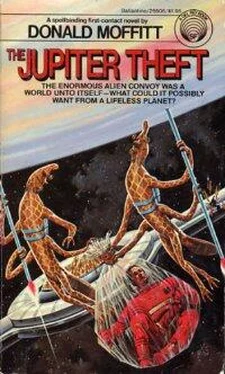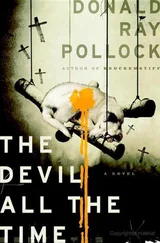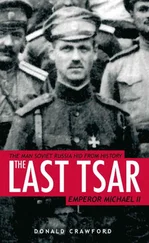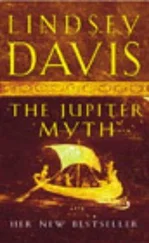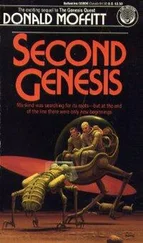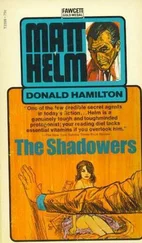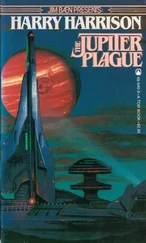Jameson groaned and got to his feet. He’d been through it all a dozen times already.
“Give the man a drink.” Somebody put a cup of warm beer into his hand. There was a friendly thump on his back as he pushed his way through the crowd, dragging Maggie.
“Is Dr. Ruiz kidding, Tod? Is this really what those walking worms showed you?”
Ruiz’s lightpad was passed hand to hand until it reached Jameson. A glowing blue diagram had been scratched on its obsidian surface.
Jameson studied the sketch. At the center was a circle with a narrow ellipse around it, like a sketch of Saturn and its rings seen almost head on. It was the Jovian planet at the center of the Cygnans’ travel arrangements, with a representation of the orbit of the robot probe that siphoned off hydrogen and turned it into kinetic energy. The Jovian’s battle-scarred moon was sketched in directly above the Jovian-probe system. Ruiz had drawn a lopsided circle to indicate its orbit. Below the moon, between the moon and the Jovian, was a circle of five small dots representing the Cygnan spaceships rotating around their common center of gravity. Their common orbit around the moon was indicated by an oval outline.
“That’s about it,” he said.
“Run through it again, Doc,” somebody said.
“All right,” Ruiz said good-naturedly. “Hold that up, Commander, so everybody can see. First we have the robot in a powered orbit around the gas giant. It’s traveling at very nearly the speed of light, using up the planet’s mass without having to accelerate it, until its own Einsteinian mass outweighs what’s left of the planet.”
“Wait a minute, Doc!” a boisterous voice said. “The centrifugal force would be tremendous!”
“You weren’t listening, Gifford. I said a powered orbit.”
“Yeah, but did you figure out the centrifugal force?”
“It doesn’t matter,” Ruiz said with rare patience. “ Whatever percentage of the total kinetic energy is needed to maintain a tight circle is progressively diverted to a thrust perpendicular to the orbit. The Cygnans aren’t concerned with efficiency. They’ve got a whole planet to use up. By the same token, a percentage of the total kinetic energy is used to provide a vector, so the Cygnans can get the whole system moving in whatever direction they want.”
Mike Berry had stopped playing the guitar and had moved into the circle. “That’s right,” he said. “All it means is that the Cygnans strip their Jovian gas tank of mass faster—or longer—before they can move what’s left.”
“Yeah,” somebody gibed. “Shut up, Giff!”
Ruiz straightened creakily. Like most of the others, he was wearing one of the crisp new uniforms Jameson had retrieved that morning, but it hung loosely on his emaciated frame.
“If we’ve got that settled,” Ruiz said, “would you flip the store-and-recall button for us, Commander? Keep doing it. Thank you.”
Jameson watched the pictures change on the black surface. Ruiz had painstakingly drawn a four-step animated diagram showing the multiple orbits. The moon jumped in its circle around the Jovian planet, moving counterclockwise. The rosette of dots jumped in its egg-shaped orbit around the moon, moving clockwise.
“The orbit of the ships around the moon has the same period as the moon’s orbit around the planet,” Ruiz went on. “Doubtless the ships’ orbits are continuously adjusted to keep them synchronized as the planet shrinks and the moon’s orbit changes. But as you can see, the ships are always sheltered from the radiation caused by collision with interstellar hydrogen.”
“Beautiful, beautiful,” Mike murmured.
“Commander Jameson thinks—and I agree with him—that a significant portion of that impacting hydrogen also becomes grist for the Cygnans’ mill. After all, it’s already been ionized. It becomes an energy bonus to partially offset the inefficiency inherent in the Cygnan method of travel.”
“Can I quit?” Jameson said. “My thumb’s getting tired.” He passed the lightpad back to Ruiz.
“It seems kinda complicated,” the Giff said, being a bad boy again.
“It wasn’t complicated for the Cygnans,” Ruiz said. “Don’t forget, they started with the components of the system already in place. That moon they use for a shield was the world they evolved on … I wonder how they feel about traveling with its corpse. The gas giant they used for fuel was the primary that their world revolved around. It would have been natural for them to start building their fleet in orbit around their world. They had a whole population to transfer, a shipboard ecology to establish, a technology to develop. It might have taken millennia. They had the time. Perhaps they didn’t develop the technology for that Einsteinian siphon of theirs until the work was well under way. They might not have traveled at relativistic speeds for the first few centuries, while they completed the shakedown for those synchronized orbits. It wouldn’t have happened all at once.”
Jameson was the first to pick up on it. “You said … they had the time. What do you mean?”
Ruiz was fiddling with his lightpad. He had more of his day’s work stored there. He looked up, almost absently.
“One of their suns was going to go supernova. And they had half a million years to get ready for it.”
The crowd around Ruiz had grown. Word had gotten about that something lively was going on. Jameson could see Liz Becque nestled against Omar, her arm around his thick waist, her post at the punchbowl deserted. Even Klein had joined the group. He was at the fringes of the crowd, his knotted arms folded, standing next to Yeh and Chia, so intent on the discussion that he’d forgotten his aversion to his Chinese shipmates.
“The Cygnans are the children of a binary system that now consists of a black hole and a blue supergiant,” Ruiz said. “They spent twenty thousand years watching one of their suns swallow the other.”
Beside Ruiz, Captain Boyle nodded gravely. “We can begin to understand something about the Cygnans’ motives now. We knew that they came from the direction of the X-ray source known as Cygnus X-l, about ten thousand light-years away. What Commander Jameson managed to see on the Cygnan computer display confirmed that it was their origin, incredible as that seems.”
Mike Berry was itchy with questions. “Twenty thousand years. That’s longer than all of human history. You sure of that figure?”
Ruiz swung his narrow beak toward him. “We can calculate the timetable for the evolution of an X-ray binary system from the mass of its components. And we get that from their dynamical behavior.”
Jameson spoke up. “The Cygnan commentary got eloquent about a ‘Great Mother’ that swallows her … not ‘children’… maybe something like ‘little brother.’ I assumed it had something to do with eclipses in a double-star system. I saw some spectacular ones.”
“It was more literal than that,” Ruiz said. “One of their suns was swallowing the other. And the mass exchange took place fast enough to be noticeable over the generations. It must have been a key part of the Cygnan race consciousness since they first crawled out of the ooze and became civilized beings.”
Liz Becque, shuddered and drew closer to Omar. “You mean they actually would have seen one of their suns getting bigger and the other getting smaller?”
“As their suns evolved, yes.”
“Think of it!” Dmitri blurted. “To live under such a sky! When you think of the burden of myth and theology we humans have invented from our own simple sunrises and sunsets and seasons…”
“The myths would have turned into scientific knowledge,” Ruiz said dryly. “When they got to the point where they knew what we know about close binaries and mass exchange, they would have known exactly what the fate of their suns would be. And exactly when it would happen.”
Читать дальше
